Upon the Passing of Giants: Richard L. Tierney, August 7, 1936 – February 1, 2022
Richard L. Tierney
It was not long ago that I wrote an obituary here for Charles R. Saunders, the father of Sword & Soul and a man who showed the possibilities of sword & sorcery/heroic fantasy in non-European settings. Now, I must poor libations for another who took a genre’s flickering torch and in his own, and very different way, showed how to keep it burning.
Richard Louis Tierney (7 August 1936 – 1 Feb 2022) was an American writer, poet and scholar of H. P. Lovecraft, in the latter category probably best known for his essay “The Derleth Mythos” in which he clearly and succinctly provided a critical analysis of Lovecraft’s nihilistic vision vs. Derleth’s more Manichaean one, that had come to dominate “Mythos” fiction in the decades after HPL’s death. As a writer of heroic fantasy, he is best known for two major works: his series of six Red Sonja novels co-authored (with David C. Smith), featuring cover art by Boris Vallejo, and his Simon of Gitta series (which “reconciled” Derleth and Lovecraft’s take on the Mythos, through the lens of historical Gnosticism). He also wrote some straight Robert E. Howard completions and pastiche, including finishing two tales of Cormac Mac Art, and co-writing (again with Smith), a novel of Bran Mak Morn (For the Witch of the Mists).
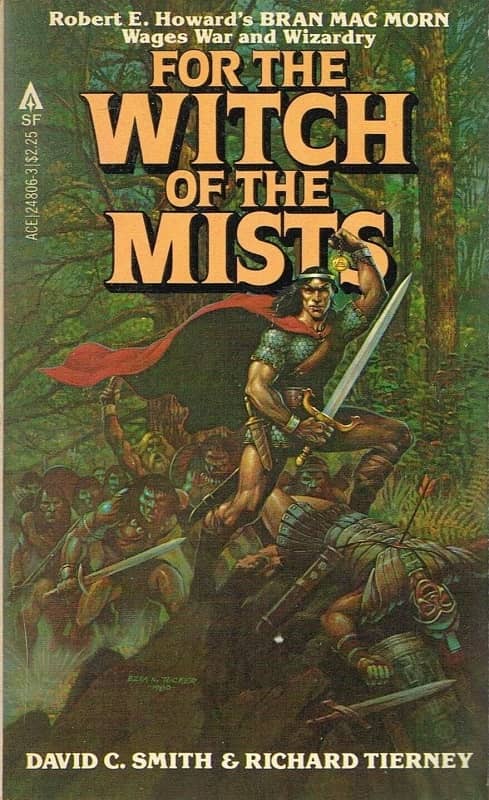 |
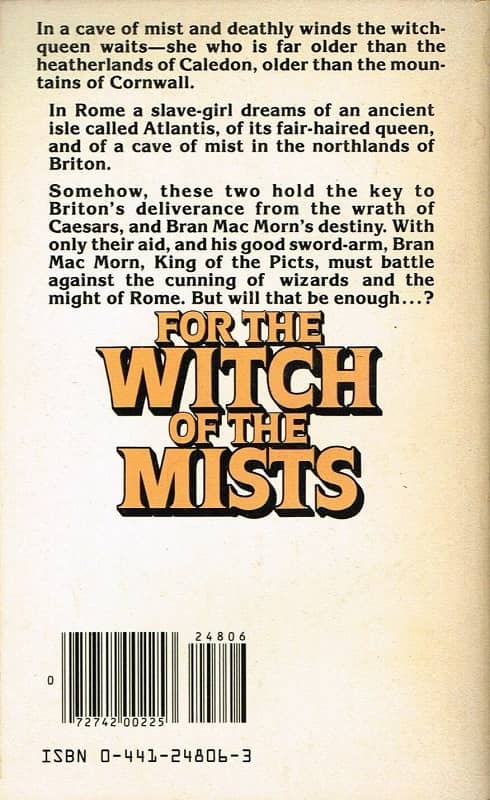 |
For the Witch of the Mists (Ace Books, March 1981). Cover by Ezra Tucker
As I will discuss, Tierney is nearly unique as a later torch-bearer of Weird Fiction, in that he combined the ideas, styles and mediums of the Big Three (Howard, Lovecraft and Clark Ashton Smith), inclusive of poetry, and even more than Karl Edward Wagner, became especially renowned for his weird and fantastic verse. In 1993, Tierney was presented with the annual Minnesota Fantasy Award. He was nominated for Science Fiction Poetry Association Grand Master in 2010.
That is a succinct summary of his literary output, of course, there is much more to a life.
Tierney was born in Spencer, Iowa, but lived in Mason City from 1942 until adulthood, and would return there later in life to end his days. Aged 15, and reading heavily in science fiction, Tierney read Lovecraft’s “The Shadow Out of Time” in Donald A. Wollheim’s Viking Portable Novels of Science and was ‘hooked’. At around the same age (15 or 16), he was inspired to write poetry by August Derleth’s fantasy verse anthology Dark of the Moon: Poems of Fantasy and the Macabre which he read. While he had previously been a devotee of the poems of Edgar Allan Poe, he was especially inspired by the H. P. Lovecraft poems in the anthology (particularly the “Fungi from Yuggoth” and also those of Donald Wandrei, Robert E. Howard, Frank Belknap Long and others).
The Viking Portable Library Novels of Science (Viking Press, 1945)
The 1950s was not a fine time for Weird Fiction. Howard and Lovecraft were dead, Clark Ashton Smith’s writing was infrequent and winding down, and the only two active writers in the genre were Fritz Leiber and Poul Anderson (the latter sometimes writing almost a “science-fantasy” take on things so he could get the stories slotted into magazines such as Amazing), and the occasional tale by Manly Wade Wellman. Leiber and Anderson cast a long shadow, but strangely, that shadow seems to have prevented many blooms from the Silent Generation, which really only produced three notable authors — Michael Moorcock, Lin Carter and John Jakes.
Moorcock needs to no explanation from me, and from homage he quickly became a radical innovator. Carter was a great editor who brought many forgotten works back to light, a pastiche writer and an author of dozens of original works of very uneven quality that are basically pastiches of his favorite authors/series. Jakes “Brak” is a significant entry to the history of S&S, but Jakes himself would ultimately find success by leaving the genre for thick, historical fiction set in American frontier, Civil War, etc.
It would fall to the Baby Boomers to truly reinvigorate the genre with Karl Edward Wagner (1945 – 1994), Charles R. Saunders (1945 – 2020), David Drake (1945 – ), David C. Smith (1952 – ), etc., all who made their mark early and often through the 70s and 80s.
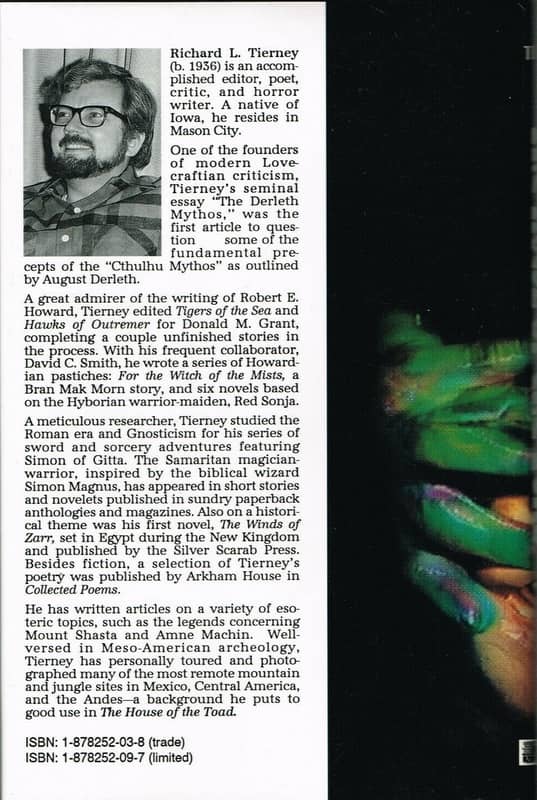 |
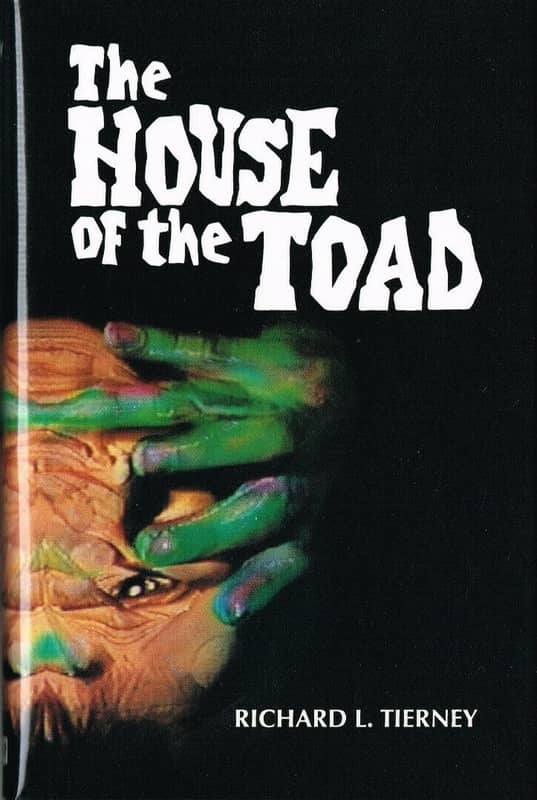 |
The House of the Toad (Fedogan & Bremer, 1993). Cover by Harry O. Morris
Tierney was discovering fantastic fiction in the height of this dry period, but with the undaunted enthusiasm of youth, began writing in the early 1950s, and came into his writing stride in his early twenties, producing numerous tales, which did not see print until the 1970s or later. His first tale was a Lovecraftian story titled “Countdown for Kalara”, which was not published until 1980, and was reprinted in Robert M. Price’s anthology The Yith Cycle (Chaosium, 2010). One of his most famous Lovecraftian tales, “The Howler in the Dark” was written in 1957 but did not see print until it appeared in Crypt of Cthulhu 24 (Vol 3, No 8, Lammas 1984); this appearance was minus a few lines of text which were restored in the printing in Robert M. Price’s anthology, The Necronomicon (Chaosium, 1996). Tierney’s first novel, The Winds of Zarr, which combined H. P. Lovecraft (including a Lovecraft-style deity named Zathog – see List of Great Old Ones), Robert E. Howard, time travel and ancient astronauts, and is set in Egypt during the New Kingdom, was penned in 1959 when Tierney was aged 23 but did not see print until 1975.
Since writing was clearly not going to provide his income, Tierney became a Forester for the US Forestry Service for 13 years (1958-1971). During this time he lived in California and the Southwest, tracked down E. Hoffman Price and established a long-lived friendship, and became well-versed in Mesoamerican archaeology, spending winters in Mexico, the Yucatan and South America visiting ancient ruins, learning to speak Spanish and making a deep-dive into Nahuatl history, language and culture. He spent much time in Yucatan and other areas photographing many of the most remote mountain and jungle sites — a background he used (along with his Iowan roots) in the Cthulhu Mythos novel The House of the Toad (1993).
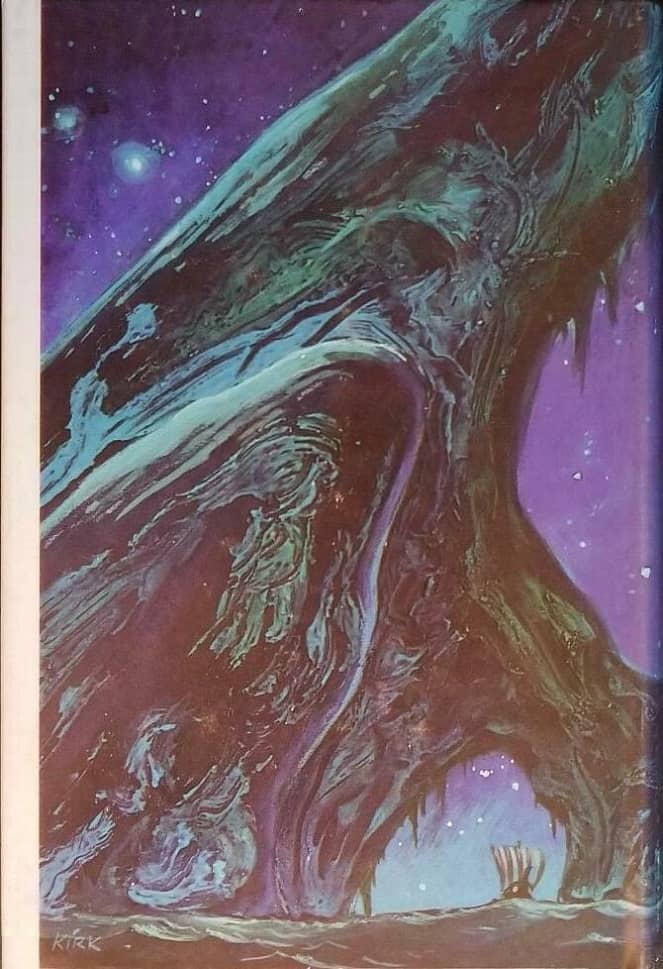 |
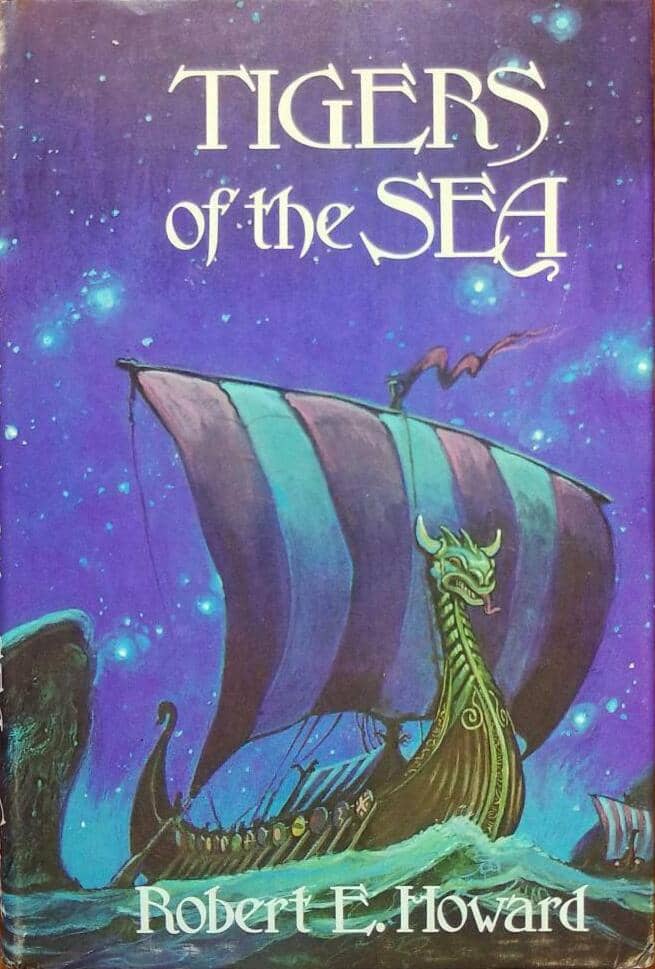 |
Tigers of the Sea (Donald M. Grant, 1974). Cover by Tim Kirk
The Derleth Mythos and Howardian Pastiche and “Posthumous Collaborations”
In 1972, Tierney moved to Minneapolis to take up writing as a vocation, and lived there for nine years, meeting old-time horror/fantasy writers such as Carl Jacobi and Donald Wandrei, as well as a small circle of new enthusiasts of Lovecraft, Smith, etc. He became a prolific contributor in the booming fanzine movement as a writer, poet and cartoonist, with his work appearing in the Esoteric Order of Dagon Amateur Press Association, Amra, Etchings and Odysseys, and Crypt of Cthulhu.
It was in this period that he authored “The Derleth Mythos”, (first published in 1972 in Meade and Penny Frierson’s HPL and reprinted in Darrell Schweitzer’s Essays Lovecraftian. The essay famously separates Lovecraft’s ideas of his Cthulhu mythos as based on a mechanistic materialist view of the universe, in which the Old Ones are entirely inimical to humankind, from the later elaborations by August Derleth whereby Derleth posited a more simplistic “good vs evil” paradigm underlying the Mythos. Essentially, Tierney argues that Lovecraft’s cosmic outlook in his fiction was not intended to convey a “good vs evil” approach. Thus Derleth’s version of the Cthulhu Mythos, which promotes the “good vs evil” concept derived from the Judaeo-Christian mythos, is untrue to Lovecraft’s fictional philosophies.
It was also during this period that, through his connections to Amra and Howard fan-circles, that Tierney was hired by Donald M. Grant to edit two volumes of Robert E. Howard stories: Tigers of the Sea (1973) (reprinted in paperback, Zebra Books, 1975) and Hawks of Outremer (1979). In Tigers of the Sea, the title story and “The Temple of Abomination” are posthumous collaborations of Tierney with Howard:
Howard’s portion ends in the second paragraph of page 209 (Zebra edition) with ‘Cormac smiled fiercely.” Mine begins with “For the moment…” Thus, as you can see, I’m the one who hauled in all the (Cthulhu) Mythos elements!
Hawks of Outremer (Donald M. Grant, June 1979). Cover by Rob Macintyre & Chris Pappas
In Hawks, the story “The Slave Princess” is the sole posthumous collaboration by Tierney with Howard; Howard wrote the first six chapters of the story, with Tierney supplying the last two. Having reread both to write this obituary, the transition is seamless, in just the way it so often was not with the “posthumous collaborations” between Howard, Carter and L. Sprague de Camp — no small feat, considering Howard’s decidedly distinctive prose.
In 1981, Tierney — a bachelor, who would remain so until his death — left Minneapolis and returned to Mason City to take care of his mother, Margaret. That year, Arkham House published his volume of weird verse, Collected Poems. Tierney found this period of living rent-free with his mother highly productive for his writing, and it was during this time he wrote his novels Thee House of the Toad, Drums of Chaos and many of the Simon of Gitta stories. Which brings us to Simon Magus.
The Red Sonja series, co-authored with David C. Smith (Ace Books, 1981-83). Covers by Boris Vallejo
Red Sonja Pastiche with David C. Smith
Tierney was also commissioned in the early 80s to write a series of the strangest pastiche’s in Howardiana I can think of, since they are not really Howard pastiche, but pastiche of Roy Thomas’s reworking of a Howard character (Red Sonya) as a Hyborian adventureress, Red Sonja, of mail-bikini fame.
I confess I avoided reading these for years, assuming they were cheap, spec-work fluff. And while they *were* spec work, together the two men produced a series of six books that are far-better than they have right to be! Whether you like different authors playing in someone else’s world or not — and I guess this is authors playing in Roy Thomas’s take of Howard’s Hyborian Age, so it is twice removed — these are really enjoyable, and it shows that if the author gets the assignment and has a passion for the craft, they can produce something far above expectations.
Simon of Gitta and the Golgotha Horror
Of all the various sword & sorcery heroes out there that came after Howard and Leiber, few are as interesting or complex, or inhabited as intriguing a world as Tierney’s Simon of Gitta. Firstly, Simon is a real person — the Samaritan and Gnostic prophet who comes down to us as “Simon Magus”, a supposed “false prophet” and magician who is killed before the Emperor Nero in a “duel of miracles” with St. Peter.
Tierney’s Simon, however, is a man of action — inspired by the lone film portrayal of the man by no less than a young Jack Palance in The Silver Chalice — an escaped gladiator who is indeed a Gnostic “old soul” — capable of remembering glimpses of his past lives, and the fact that his spirit is divine, trapped in the world of flesh by the Lords of Pain (the Gnostic archons, here transformed into Lovecraft’s Great Old Ones). Seeking vengeance on Rome, Simon meets the ancient sage Dositheus (clearly a Deep One-human hybrid who also looks rather like…. er…. Yoda) who tutors him in magic and reveals to him his true nature.
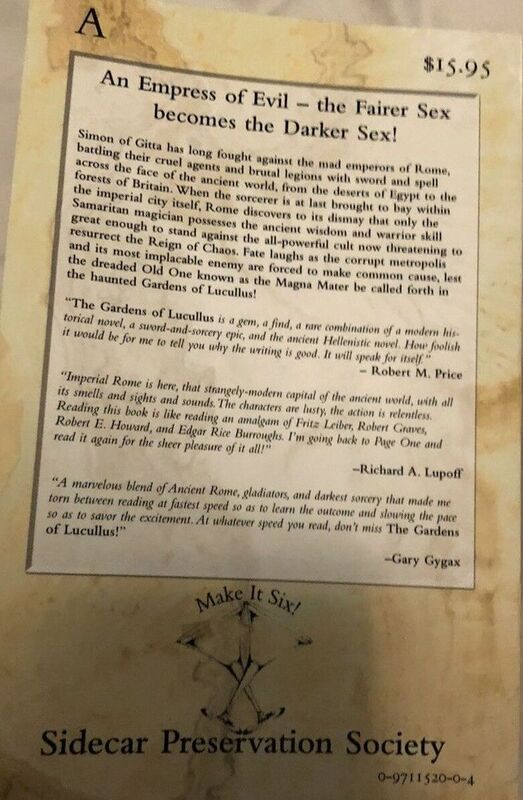 |
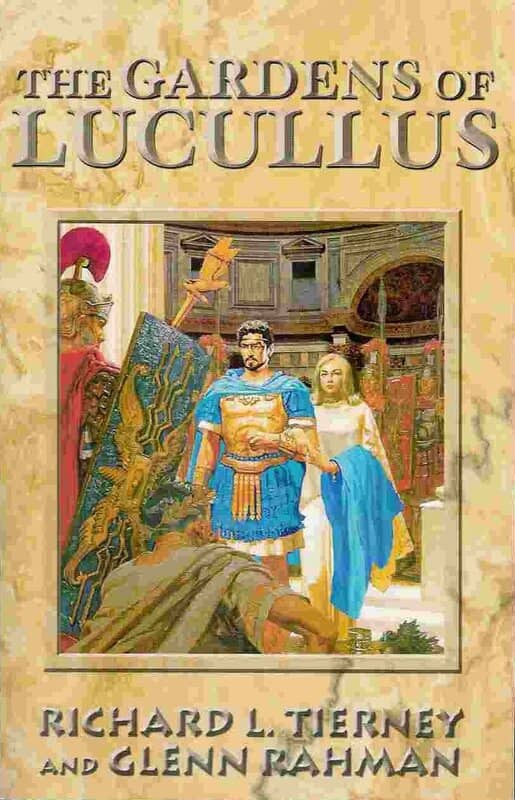 |
The Gardens of Lucullus by Richard Tierney and Glenn Rahman (Sidecar Preservation Society, January 1, 2001)
From this premise, Tierney builds a fascinating saga in which Simon finds — and loses — his true love, an incarnation of the sacred goddess Sophia, and is determined to find her next incarnation, and to have vengeance on Rome. Along the way, he encounters two different Emperors, finds the resting place where Cain is kept captive (here portrayed, in a brilliant homage, as Karl Edward Wagner’s Kane), learns a number of secrets behind the Egyptian mystery religions, is nearly swallowed by a sandworm, battles the vampiric Pontius Pilate (I won’t reveal how Pilate’s fate comes about but it’s really clever), orchestrates a clash between Deep Ones and servants of Cthugha, steals the dreaded Ring of Thoth (which is Thoth-Amon, whose magic ring existed in Howard’s fiction both in Conan’s era and the modern one — Tierney here helps show how it made its way through the centuries), and tutors the young Menander (who was another Gnostic prophet and protégé of the real Simon). All set against a mystical love story of the divine “union of opposites” of Gnostic lore.
There isn’t another S&S character quite like Simon, or an author who does such a brilliant job of uniting Howard’s blood-and-thunder style of writing, CAS’s wry wit and Derleth’s take on the mythos, that here becomes reconciled to Lovecraft’s own terrifying vision of a vast, uncaring universe. Brilliant stuff.
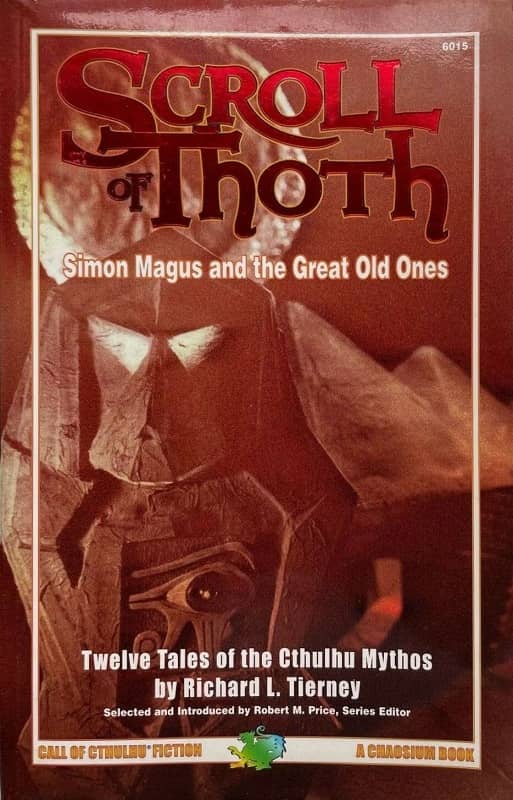 |
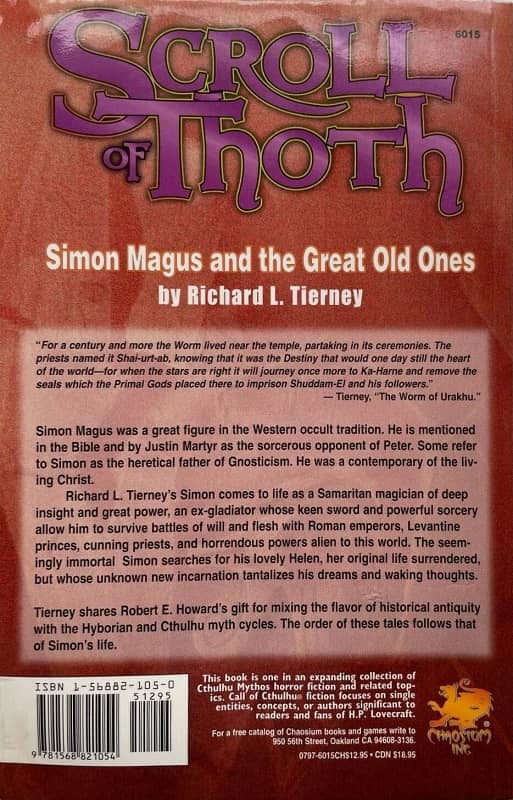 |
The Scroll of Thoth: Simon Magus and the Great Old Ones (Chaosium, September 1997)
The Simon tales were published in a variety of anthologies and zines, but I became aware of them when Robert M. Price collected them for the first time in The Scroll of Thoth (Chaosium, 1997). The saga also exists in two novels: The Gardens of Lucellus with Glen Rahman (2001) and Tierney’s magnum opus, The Drums of Chaos, which is set during the time of Christ’s passion. Simon of Gitta is on a mission to avenge the deaths of his parents, seeking revenge in blood against the Roman officials who committed the murders. As he travels the Holy Lands with his mentor Dositheus, and their student Menander, they become entangled in a complex plot in which Jesus is revealed to indeed be the son of (a) god; a 1st century Whilber Whately, who is yet somehow also the loving figure of the Gospels. John Taggart, the time traveler from Tierney’s The Winds of Zarr becomes involved with Simon of Gitta, as their separate quests converge toward a common goal of saving.
A Grey God Passes
For the last decade or so, Richard Tierney’s writing had focused on poetry, a field of literature a shade of its former self in popularity and infinitely more so for Weird poetry, but by now he was clearly writing for himself alone.
Sadly, Tierney suffered a stroke in 2020 that put him into a nursing him, though mentally clear and still capable of writing. He survived a bout with covid. Unfortunately, post-surgical complications from a broken ankle repair caused his health to fade over the last few weeks, and he passed into the Pleroma (as the Gnostics might say) at the start of this month.
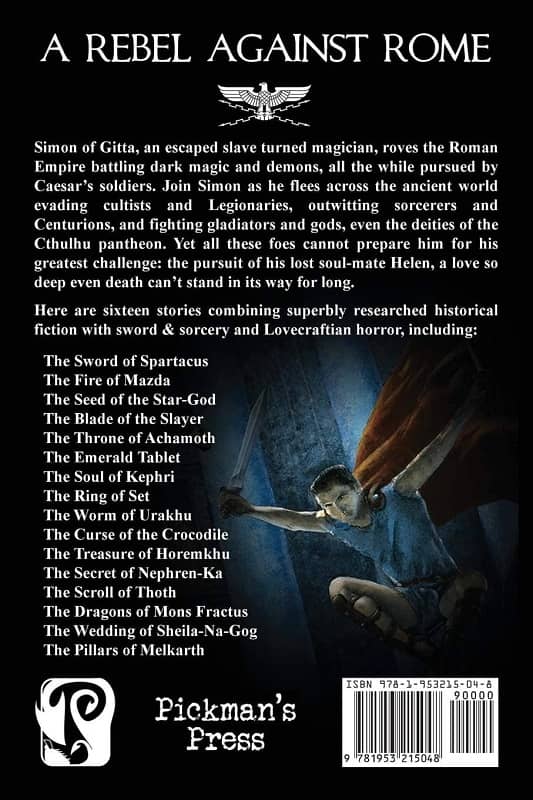 |
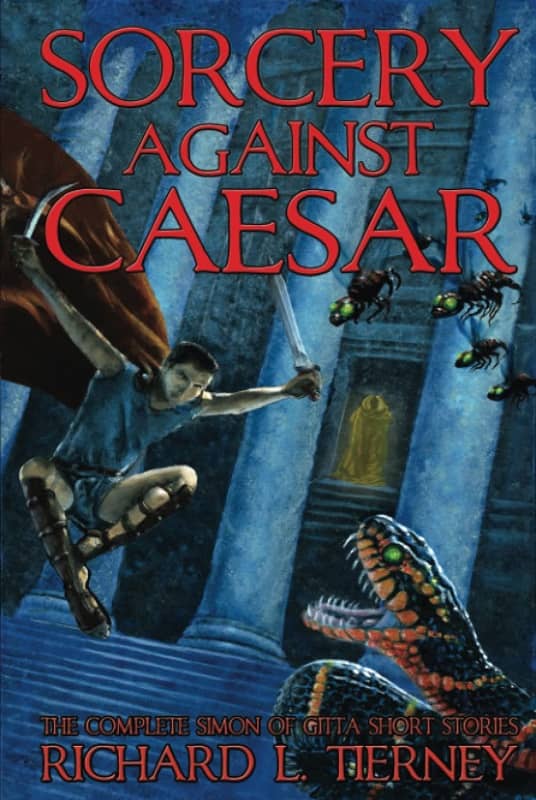 |
Sorcery Against Caesar: The Complete Simon of Gitta Short Stories (Pickman’s Press, December 2020)
Allegedly, Tierney was working on a new novel collaboration with Glenn Rahman, presumably in the Simon cycle, The Path of the Dragon, prior to his death. Whether this will ever come to fruition now, is unknown. Fortunately, Pickman’s Press reprinted an expanded edition of The Scroll of Thoth as Sorcery Against Caesar: The Complete Simon of Gitta Short Stories by Richard L. Tierney and Divers Hands, edited by Edward Stasheff. (Edgewood, NM: Pickman’s Press, 2020). The expanded edition includes all 16 Simon of Gitta stories, including two published after The Scroll of Thoth appeared – “The Emerald Tablet” and “The Secret of Nephren-Ka”) and a poem, “Vengeance Quest.”
Price’s Introduction from The Scroll of Thoth is included in abridged form; his original story notes are reprinted for the tales from The Scroll of Thoth, while Edward Stasheff provides story notes for the other tales. Drums of Chaos was also reissued by Pickman’s Press in late 2021. Pickman’s is also preparing a volume of his poetry. I can only hope that perhaps Garden of Lucellus and House of the Toad will also make it into their sights, which would thereby but the core of his work back in print and available to new readers.
I was late to Tierney fandom, having first discovered him with Scroll of Thoth (see above) in the mid-1990s, but few writers have inspired by own short-story writing so much as him, and I am grateful I found his work when I did. So please take a moment to raise a glass and honor the work of an author who should have been better-known, and whose work is decidedly worthy of memory.
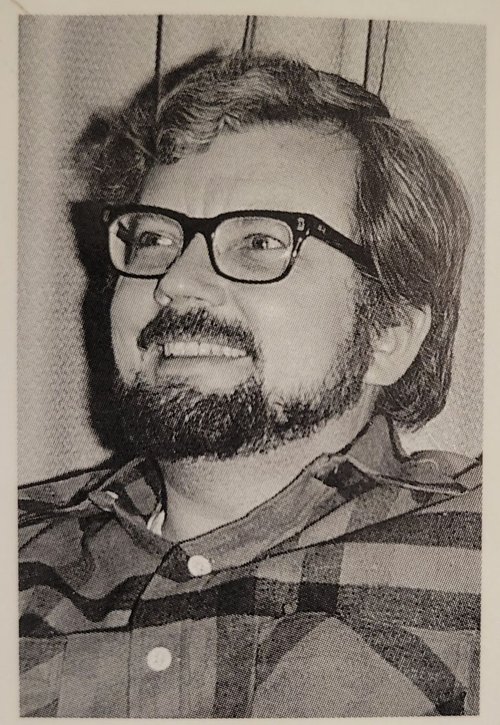
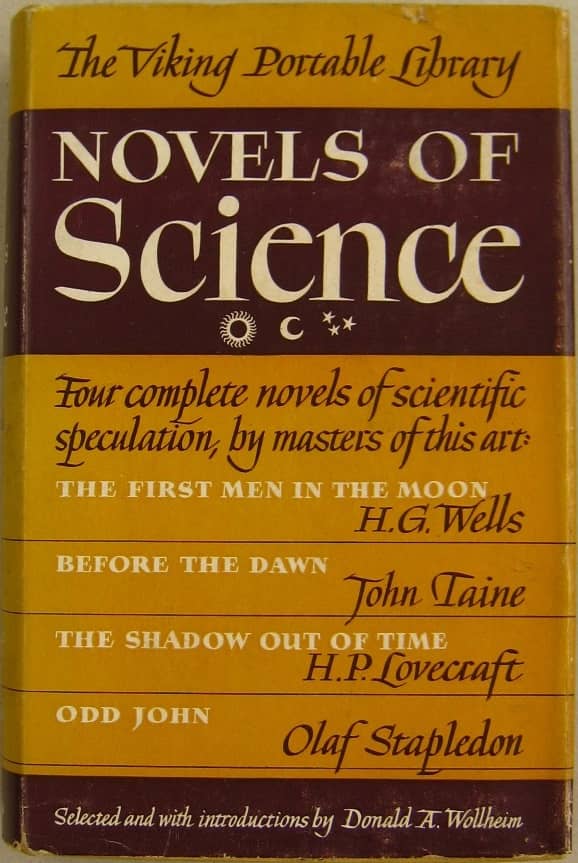
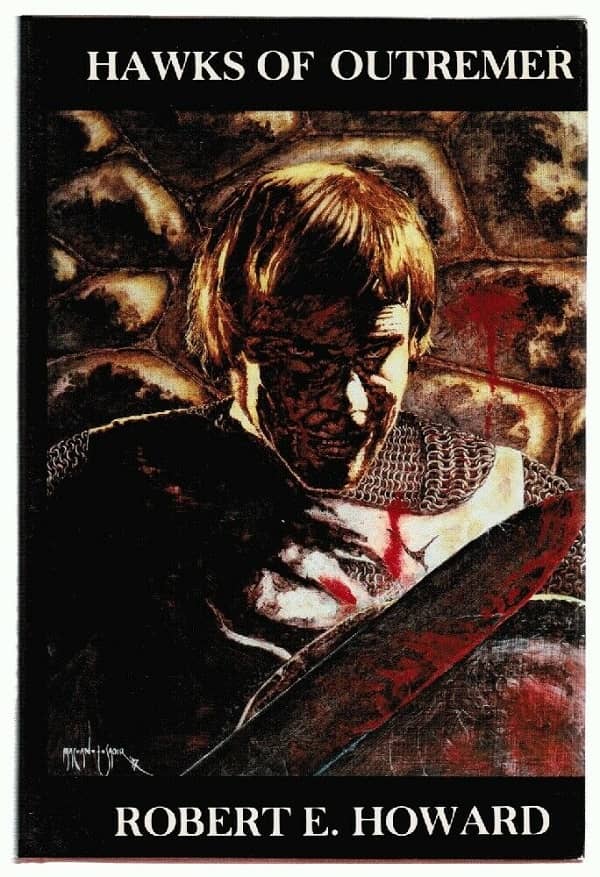
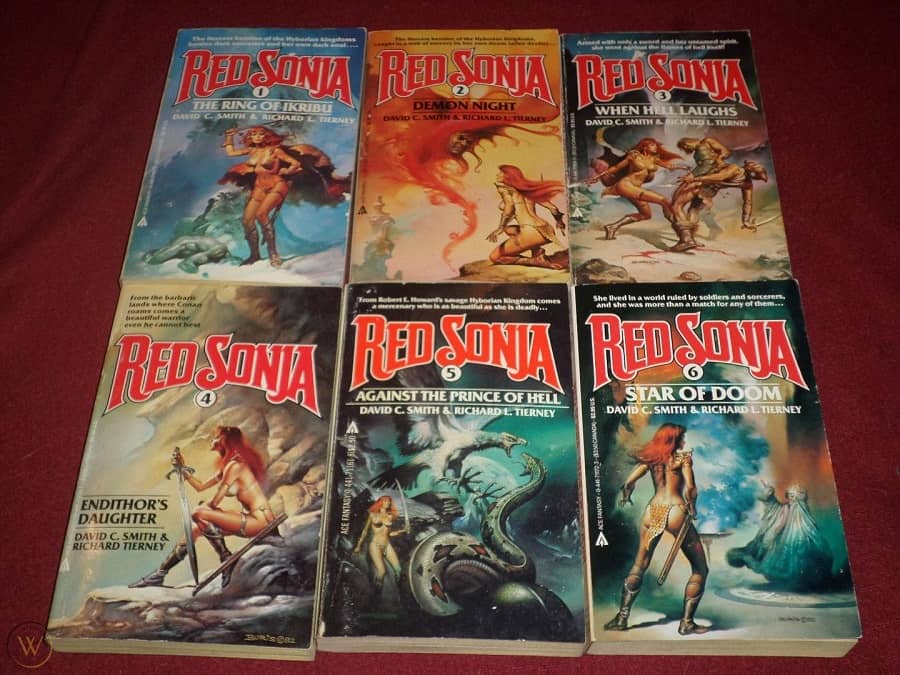
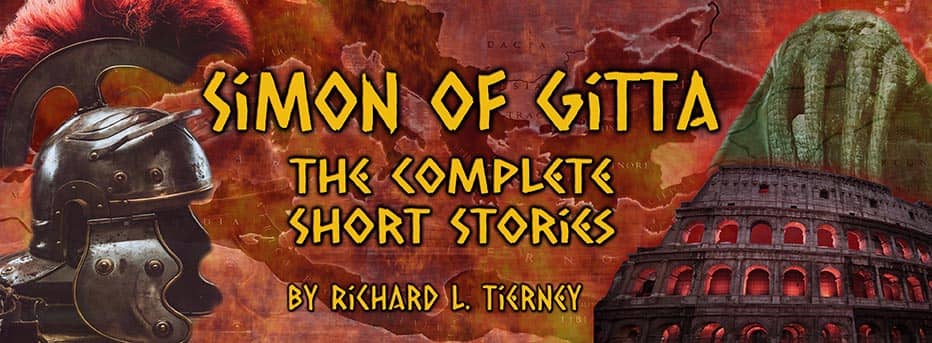
You just sent me out to the garage bookshelves to retrieve my copy of the Scroll of Thoth, which I haven’t had in my hands for probably twenty years or more. It’ll be nice to dip into it again.
Excellent! Even though I have it, I went and ordered Sorcery Against Caesar, just to have all of the Simon short stories and poems in one place. There are also two pastiche in the collection by Robert M. Price, but they are lackluster, at best. The intro is also a shortened version of the very detailed one in Scroll. So I am happy to have both!
Greg, this is excellent. Thank you so much. I learned a few things about Dick here that I had not known. This is amusing; it ties in with how precocious he was as a boy. When my wife and I visited Dick and his mom in Mason City, shortly after we moved to Chicago, his mom told us that Dick’s favorite novel when he was a boy was The Count of Monte Cristo, which he read more than once. Maybe a hint there of the heroic personages to come from him? He was so imaginative and brilliant, with a mind that went in all directions, it was always a treat sitting down and talking with him. He visited us once when we lived on the west side of Cleveland; I recall our discussing the fate of mankind over Chinese lunch in a little restaurant in a shopping center. Dick wasn’t so sure the human race was worth saving; I played devil’s advocate and argued we were worth it. We left it at that, coming to no conclusion. Man, he was sharp. It was an honor and a pleasure to have known him and worked with him.
I would dearly have loved to have met him and had just that argument — I go back and forth between those two poles myself — and chatted about Gnosticism and Roman mystery cults, which are passions of mine. In the strangest of coincidences, I was reading “For the Witch of the Mists”, the one collab of yours I’d never read, when news came he had passed. It’s interesting, because in Aeysla’s story there seemed a prototype for the Helen of the Simon tales.
Truly with his and Charles Saunders’ pen silenced, this corner of the literary world is far less lyrical.
This is a wonderful tribute, Greg. I know Tierney only though his association with our friend and mutual collaborator, David C. Smith. Sadly, I never had the pleasure of meeting him in person – but I am a huge fan of his work, especially the Simon of Gitta stories. Tierney’s smiling right now, thanks to you.
Thanks Joe, that means a lot.
The crossover with Kane – Blade of the Slayer – is one of the best SW&SC I’ve read…
The setting IMO reminds me of “Great Zimbabwe” the big stone rings for walls for cities and having Kane talking about those early days, this Grim Dark monster of a man I can almost feel a sob being suppressed in his voice.
RIP Tierney, we love your works and will pass them on like the Copybooks you made in the 70s – also tell others of digital works also. Does the digital sale benefit anyone? I wouldn’t begrudge a legit publisher getting some $ but it’d be neat to know.
As of today, there are Kindle editions of the Drums of Chaos for $5.99 and Sorcery Against Caesar for 99 cents.
The first time I heard of THE PATH OF THE DRAGON was at least 20 years ago, and it is listed in the P’rea Press Tierney bibliography as “unpublished” (not “unfinished”), so chances are good that it will appear. In addition, the latest newsletter from Pickman’s Press has this to say:
“Before he passed away, Pickman’s Press signed a contract with Tierney to release all the Simon of Gitta novels as ebooks and paperbacks, including a reprint of The Gardens of Lucullus and the previously unpublished novel Path of the Dragon, both co-written by Richard Tierney and Glenn Rahman, as well as Heir of Darkness by Glenn Rahman, a novel set in the same fiction-historical universe as the Simon tales, but featuring a different hero.
I’m also currently negotiating with Tierney’s estate to publish a collection of his John Taggart sci-fi horror stories, although that’s still in the preliminary stages and by no means a done deal. Keep an eye on the Pickman’s Press Facebook page to stay informed.”
Ave, Richard L. Tierney.
I am not too worried about THE PATH OF THE DRAGON; I first heard about it 20+ years ago, and in the Tierney bibliography that P’rea Press published in 2008 it is listed as “unpublished”, not “unfinished”. Also, the latest Pickman’s Press newsletter gives no indication of concern:
“Before he passed away, Pickman’s Press signed a contract with Tierney to release all the Simon of Gitta novels as ebooks and paperbacks, including a reprint of The Gardens of Lucullus and the previously unpublished novel Path of the Dragon, both co-written by Richard Tierney and Glenn Rahman, as well as Heir of Darkness by Glenn Rahman, a novel set in the same fiction-historical universe as the Simon tales, but featuring a different hero.
I’m also currently negotiating with Tierney’s estate to publish a collection of his John Taggart sci-fi horror stories, although that’s still in the preliminary stages and by no means a done deal. Keep an eye on the Pickman’s Press Facebook page to stay informed.”
SORCERY AGAINST CAESAR actually includes more stories that were not included in THE SCROLL OF THOTH: “The Marriage of Sheila-na-Gog” and “The Throne of Achamoth”.
Finally, I don’t think it is Pickman’s Press that is preparing a collection of poetry, but I do know that P’rea Press is preparing a new, expanded edition of SAVAGE MENACE.
That’s all great news. “Gardens” is actually a better novel, IMO, than “Drums” which, while Tierney’s opus, is actually too long and a bit convoluted. “Heir of Darkness” stars Simon’s sidekick from “Gardens” and is pretty fun in its own right. I did mention in the article that SORCERY is more complete than SCROLL; it has the two you mentioned plus an epic poem recounted by Simon himself. (It also has two stories by Robert M. Price)